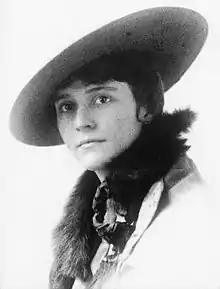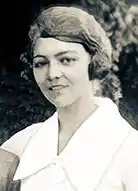The Big Four were a quartet of debutantes in the Chicago social scene during World War I who viewed themselves as "the four most attractive and socially desirable young women in Chicago."[1] The quartet consisted of Ginevra King, Edith Cummings, Courtney Letts, and Margaret Carry.[2][3] The Big Four—a name they coined and bestowed upon themselves—were the preeminent socialites of their era, and each wore a rose-gold pinkie ring with phrase, "The Big Four 1914," engraved on the inner band.[3]
Background
Each of the Big Four was born around the turn of the century and came from a wealthy family in the Chicago area. Raised in luxury on their family's sprawling estates in Lake Forest,[4][5][6] the quartet enjoyed carefree lives consisting of polo, tennis, country-club flirtations and private-school feuds.[6] Due to the immense wealth of their respective families, the Chicago press chronicled their mundane social activities, and newspaper columnists feted the young women as the city's most desirable debutantes.[7][8]
In the summer of 1914, these friends began referring to themselves as "The Big Four", even getting rings engraved with "The Big Four 1914". They went to dances and house parties together, and they were seen as a foursome on the golf links and tennis courts at Onwentsia. They were "so legendary for their beauty that they were known by that designation for the rest of their lives."[4]
Members
Ginevra King
Ginevra King (November 30, 1898 – December 13, 1980), daughter of Chicago financier Charles King, is best known for her romantic relationship with, and being a muse for, F. Scott Fitzgerald. She was the inspiration for the character of Daisy Buchanan in The Great Gatsby. King married twice, to William Mitchell and John T. Pirie Jr.
Edith Cummings
Edith Cummings (March 26, 1899 – November 20, 1984) was one of the premier golfers of her generation. In 1923, she won the U.S. Women's Amateur, and she appeared on the August 25, 1924, cover of Time magazine.[9] She was also a big game hunter and equestrienne. In 1934, she married Curtis Burton Munson.[10]
Cummings met F. Scott Fitzgerald through King, and was the inspiration for the character of Jordan Baker in The Great Gatsby.[11]
Courtney Letts
Courtney Louise Letts (June 17, 1899 – April 7, 1995), born in Iowa,[12] was the daughter of Frank Crawford Letts and Cora Perkins. She married Wellesley H. Stillwell on January 10, 1920.[13] They divorced in 1924, and in 1925, she married John Borden, with whom she traveled to the Arctic; this provided the material for her 1928 book The Cruise of the Northern Light. They divorced in 1933 and three weeks later, she married Argentine ambassador Felipe de Espil, who had courted her in the early 1920s.
While married to Espil, she became "one of the world's ten best-dressed women, and an able diplomat herself."[14] In 1943, they moved back to Buenos Aires, and then in 1945 to Madrid when Felipe was appointed Argentina's ambassador to Spain. In 1955, he became ambassador to Brazil, and then around 1959, he and Courtney retired to Buenos Aires. Felipe died in 1972. After moving to New York, she married Foster Adams in 1974. She died April 7, 1995, in Washington, D.C.
Works by Letts:
- The Cruise of the Northern Light - New York: Macmillan Co. 1928. (Mechanicsburg, PA: Stackpole Books. 2004. ISBN 0-8117-3140-5)
- Adventures in a Man's World - New York: Macmillan Co. 1933. (Mechanicsburg, PA: Stackpole Books. 2005. ISBN 0-8117-3205-3)
- La Esposa del Embajador - Buenos Aires: Editorial Jorge Alvarez S.A. 1967. (Spanish)
- Noticias Confidenciales de Buenos Aires a USA (1869-1892) - Buenos Aires: Editorial Jorge Alvarez S.A. 1969. (Spanish)
Margaret Carry
Margaret "Peg" Carry (1899/1900 – 1942)[15] was the daughter of Edward F. Carry,[16] one-time president of the Pullman Company and assistant to Edward Nash Hurley, chairman of the Shipping Board, during World War I.[17] She is mentioned by F. Scott Fitzgerald in his Ledger from August 1916: "Lake Forest. Peg Carry. Petting party ... The dinner at Peg's ... Peg Carry stands straight".
She married Edward Cudahy Jr. on December 28, 1919, in Chicago's Holy Name Cathedral. She died in 1942.
Citations
- ↑ Diamond 2012; Corrigan 2014, p. 59; Rothman 2012, p. K12.
- ↑ Bleil 2008, p. 32; West 2005, pp. 8–9; Diamond 2012.
- 1 2 Rothman 2012, p. K12.
- 1 2 Donaldson 1999, p. 35.
- ↑ Dreier, Mollenkopf & Swanstrom 2004, p. 37: "Lacking the outward signs of high status that the landed nobility of Europe once enjoyed, wealthy American families have long maintained social distance from the 'common people' by withdrawing into upper-class enclaves. Often located on forested hills far from the stench and noise of the industrial distracts, places like Greenwich, Connecticut; Lake Forest, Illinois; and Palm Beach, Florida, are 'clear material statement[s] of status, power, and privilege.'"
- 1 2 Corrigan 2014, p. 58.
- ↑ Diamond 2012; Corrigan 2014, p. 59.
- ↑ Chicago Tribune 1914, p. 11; Chicago Tribune 1918, p. 15; Rothman 2012, p. K12.
- ↑ Stevens, Peter F. "The Fairway Flapper". - Golf Magazine - July 1999
- ↑ "Milestones". - Time - April 16, 1934
- ↑ West 2005b.
- ↑ "Courtney Letts de Espil: A Register of Her Papers at the Library of Congress" Archived 2007-09-30 at the Wayback Machine - Manuscript Division, Library of Congress
- ↑ Cook County, Illinois, Marriage Index, 1871-1920
- ↑ "Senor & Senora", Time, October 18, 1943, archived from the original on November 15, 2005
- ↑ "Mrs. Margaret C. Cudahy" - "The New York Times" - June 15, 1942
- ↑ "Marriage Announcement 1" - The New York Times - December 11, 1919
- ↑ Hurley, Edward N. The Bridge to France
Works cited
- Bleil, Robert Russell (December 2008). Temporarily Devotedly Yours: The Letters of Ginevra King to F. Scott Fitzgerald (Thesis). University Park, Pennsylvania: Pennsylvania State University. Retrieved January 1, 2023.
- Donaldson, Scott (1999). Hemingway Vs. Fitzgerald: The Rise And Fall Of A Literary Friendship. Woodstock, New York: Overlook Press. ISBN 978-0-87951-711-3 – via Internet Archive.
Margaret (Peg) Cary was a close friend of Ginevra's. With Courtney Letts and Edith Cummings, they made up the 'Big Four' debutantes of the time, girls so legendary for their beauty that they were known by that designation for the rest of their lives. In the late 1970s, I met a fellow from Lake Forest at the Yale Club bar in New York City, and asked him if possibly he had heard of 'the Big Four,' who would have been at least a decade his senior. He had indeed—everyone in Lake Forest had— and he could tell me about their subsequent marriages and divorces as well.
- Corrigan, Maureen (September 9, 2014). So We Read On: How The Great Gatsby Came to Be and Why It Endures. New York City: Little, Brown and Company. ISBN 978-0-316-23008-7 – via Internet Archive.
- Diamond, Jason (December 25, 2012). "Where Daisy Buchanan Lived". The Paris Review. New York City. Retrieved January 1, 2023.
- Dreier, Peter; Mollenkopf, John; Swanstrom, Todd (2004). Place Matters: Metropolitics for the Twenty-first Century (2nd rev. ed.). University Press of Kansas. p. 37. ISBN 0-7006-1364-1 – via Google Books.
- "Miss Ginevra King, Who Weds Sept. 4, Lake Geneva Guest". Chicago Tribune. Chicago, Illinois. August 20, 1918. p. 15. Retrieved January 1, 2023 – via Newspapers.com.
Miss Ginevra King, whose marriage to Ensign William H. Mitchell will take place on Sept. 4, is spending a few days with Mr. and Mrs. John J. Mitchell at Lake Geneva.... Miss King... spent the week end with Miss Edith Cummings in Lake Forest.
- Rothman, Joshua (August 5, 2012). "Fitzgerald's Muse". The Boston Globe (Sunday ed.). Boston, Massachusetts. p. Page K12. Retrieved January 1, 2023 – via Newspapers.com.
- "Some Feminine Tennis Experts in Action". Chicago Tribune. Chicago, Illinois. Jul 30, 1914. p. 11. Retrieved January 1, 2023 – via Newspapers.com.
Society has taken great interest in 'tennis week' at the Onwentsia club.... Miss Ginevra King... play excellent games.
- West, James L. W. (September 1, 2005b). "F. Scott Fitzgerald's Winter Dreams". The Washington Post. Washington, D.C.
- West, James L. W. (2005). The Perfect Hour: The Romance of F. Scott Fitzgerald and Ginevra King, His First Love. New York: Random House. ISBN 978-1-4000-6308-6 – via Internet Archive.

